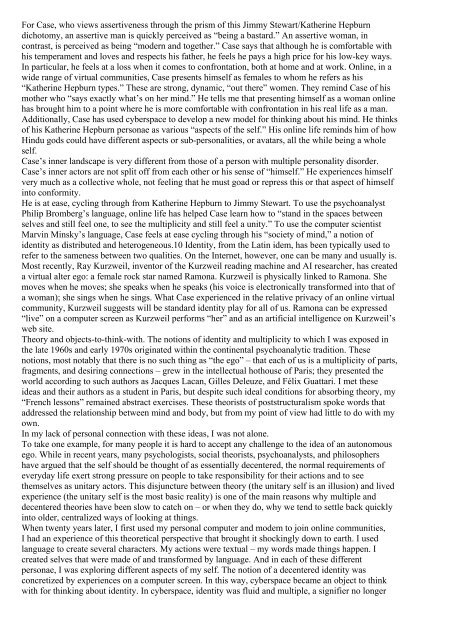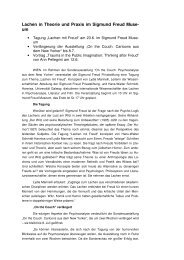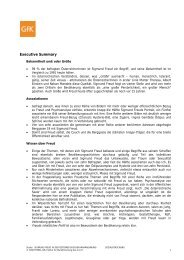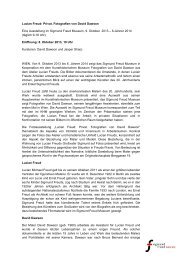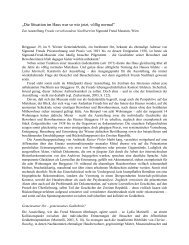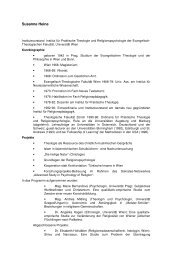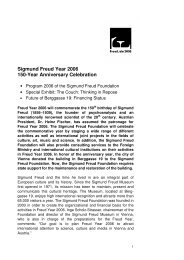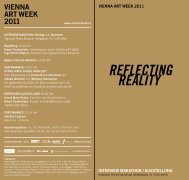Sigmund Freud-Museum | Newsletter - Sigmund Freud Museum Wien
Sigmund Freud-Museum | Newsletter - Sigmund Freud Museum Wien
Sigmund Freud-Museum | Newsletter - Sigmund Freud Museum Wien
Create successful ePaper yourself
Turn your PDF publications into a flip-book with our unique Google optimized e-Paper software.
For Case, who views assertiveness through the prism of this Jimmy Stewart/Katherine Hepburn<br />
dichotomy, an assertive man is quickly perceived as “being a bastard.” An assertive woman, in<br />
contrast, is perceived as being “modern and together.” Case says that although he is comfortable with<br />
his temperament and loves and respects his father, he feels he pays a high price for his low-key ways.<br />
In particular, he feels at a loss when it comes to confrontation, both at home and at work. Online, in a<br />
wide range of virtual communities, Case presents himself as females to whom he refers as his<br />
“Katherine Hepburn types.” These are strong, dynamic, “out there” women. They remind Case of his<br />
mother who “says exactly what’s on her mind.” He tells me that presenting himself as a woman online<br />
has brought him to a point where he is more comfortable with confrontation in his real life as a man.<br />
Additionally, Case has used cyberspace to develop a new model for thinking about his mind. He thinks<br />
of his Katherine Hepburn personae as various “aspects of the self.” His online life reminds him of how<br />
Hindu gods could have different aspects or sub-personalities, or avatars, all the while being a whole<br />
self.<br />
Case’s inner landscape is very different from those of a person with multiple personality disorder.<br />
Case’s inner actors are not split off from each other or his sense of “himself.” He experiences himself<br />
very much as a collective whole, not feeling that he must goad or repress this or that aspect of himself<br />
into conformity.<br />
He is at ease, cycling through from Katherine Hepburn to Jimmy Stewart. To use the psychoanalyst<br />
Philip Bromberg’s language, online life has helped Case learn how to “stand in the spaces between<br />
selves and still feel one, to see the multiplicity and still feel a unity.” To use the computer scientist<br />
Marvin Minsky’s language, Case feels at ease cycling through his “society of mind,” a notion of<br />
identity as distributed and heterogeneous.10 Identity, from the Latin idem, has been typically used to<br />
refer to the sameness between two qualities. On the Internet, however, one can be many and usually is.<br />
Most recently, Ray Kurzweil, inventor of the Kurzweil reading machine and AI researcher, has created<br />
a virtual alter ego: a female rock star named Ramona. Kurzweil is physically linked to Ramona. She<br />
moves when he moves; she speaks when he speaks (his voice is electronically transformed into that of<br />
a woman); she sings when he sings. What Case experienced in the relative privacy of an online virtual<br />
community, Kurzweil suggests will be standard identity play for all of us. Ramona can be expressed<br />
“live” on a computer screen as Kurzweil performs “her” and as an artificial intelligence on Kurzweil’s<br />
web site.<br />
Theory and objects-to-think-with. The notions of identity and multiplicity to which I was exposed in<br />
the late 1960s and early 1970s originated within the continental psychoanalytic tradition. These<br />
notions, most notably that there is no such thing as “the ego” – that each of us is a multiplicity of parts,<br />
fragments, and desiring connections – grew in the intellectual hothouse of Paris; they presented the<br />
world according to such authors as Jacques Lacan, Gilles Deleuze, and Félix Guattari. I met these<br />
ideas and their authors as a student in Paris, but despite such ideal conditions for absorbing theory, my<br />
“French lessons” remained abstract exercises. These theorists of poststructuralism spoke words that<br />
addressed the relationship between mind and body, but from my point of view had little to do with my<br />
own.<br />
In my lack of personal connection with these ideas, I was not alone.<br />
To take one example, for many people it is hard to accept any challenge to the idea of an autonomous<br />
ego. While in recent years, many psychologists, social theorists, psychoanalysts, and philosophers<br />
have argued that the self should be thought of as essentially decentered, the normal requirements of<br />
everyday life exert strong pressure on people to take responsibility for their actions and to see<br />
themselves as unitary actors. This disjuncture between theory (the unitary self is an illusion) and lived<br />
experience (the unitary self is the most basic reality) is one of the main reasons why multiple and<br />
decentered theories have been slow to catch on – or when they do, why we tend to settle back quickly<br />
into older, centralized ways of looking at things.<br />
When twenty years later, I first used my personal computer and modem to join online communities,<br />
I had an experience of this theoretical perspective that brought it shockingly down to earth. I used<br />
language to create several characters. My actions were textual – my words made things happen. I<br />
created selves that were made of and transformed by language. And in each of these different<br />
personae, I was exploring different aspects of my self. The notion of a decentered identity was<br />
concretized by experiences on a computer screen. In this way, cyberspace became an object to think<br />
with for thinking about identity. In cyberspace, identity was fluid and multiple, a signifier no longer


